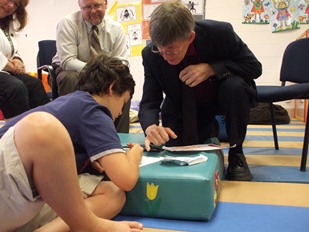Nisonger Center Studies ADHD Drug, Parent Training for Autism
March 30, 2012

|
Researchers at The Ohio State University are conducting a study to determine which is more effective for helping children on the autism spectrum: training parents or taking medication.
Researchers at Ohio State's Nisonger Center (OH UCEDD/LEND) are studying whether a particular non-stimulant typically used to treat children with attention deficit hyperactivity disorder can help children with autism. At the same time, researchers are also analyzing the benefits of a training intervention for parents of children with autism to help curb attention problems, hyperactivity and noncompliance.
During the study, some patients will receive a drug known as atomoxetine, while others will receive a placebo. And some parents will be taught intervention techniques by a professional to better control their children's symptoms of autism, while others will not receive the additional parent training, said principal investigator Michael Aman, director of research at the Nisonger Center at the Ohio State University Wexner Medical Center.
As for the role of the parent, Aman says therapists will teach parents behavior techniques to help them better manage behavioral issues in children. There are subtle clues that parents can be taught to recognize and help prevent problems before they start, according to Aman. In addition, certain reward techniques have proven effective in clinical settings.
"We're trying to have the greatest possible impact on children with autism," says Aman, a professor of psychology and psychiatry who focuses on pharmacological and behavioral studies for children. "Obviously it gives us an opportunity to look at each technique in isolation, but more importantly, it enables us to look at the combination of the two treatments to see if there is a bonus."
Atomoxetine is already approved for use in children with ADHD, but this marks the first large-scale study using this drug in children on the autism spectrum, Aman said.
"We think there is a better chance that this drug will work for children when stimulants have failed, because it actually works on a different neuro-chemical," Aman says. "So, the chance of seeing a breakthrough on a child who has yet to respond to the stimulants is much greater."
"By combining the pill and the parental involvement, we're hoping that we'll see an effect which is greater than with the use of either treatment alone," Aman says.
The study is open to boys and girls ages 5 to 14 who are in good health and have been diagnosed with autistic disorder, pervasive developmental disorder not otherwise specified (PDD-NOS), or Asperger's disorder.
After the first 10 weeks, study participants may continue in the treatment program based on how they responded during the first phase of the study. This includes the opportunity to receive the real medicine if they received the placebo earlier.
The study is currently taking place at the Nisonger Center at Ohio State University, in conjunction with the University of Pittsburgh and the University of Rochester in New York.
For more information about the study, go to http://nisonger.osu.edu/study_participation and click on "CHARTS Website" or call 614-688-8214.
The Nisonger Center, a University Center for Excellence in Developmental Disabilities, is part of The Ohio State University Wexner Medical Center and was founded in 1966 to provide assistance to people with disabilities, families, service providers and organizations by promoting inclusion of people with disabilities in education, health, employment and community setting.
# # #
Broadcast quality video and sound bites are available at: http://bit.ly/w5eBFv
Contact: Eileen Scahill, Medical Center Public Affairs and Media Relations, 614-293-3737, or [email protected]
Read more: http://nisonger.osu.edu/features/adhd-study







